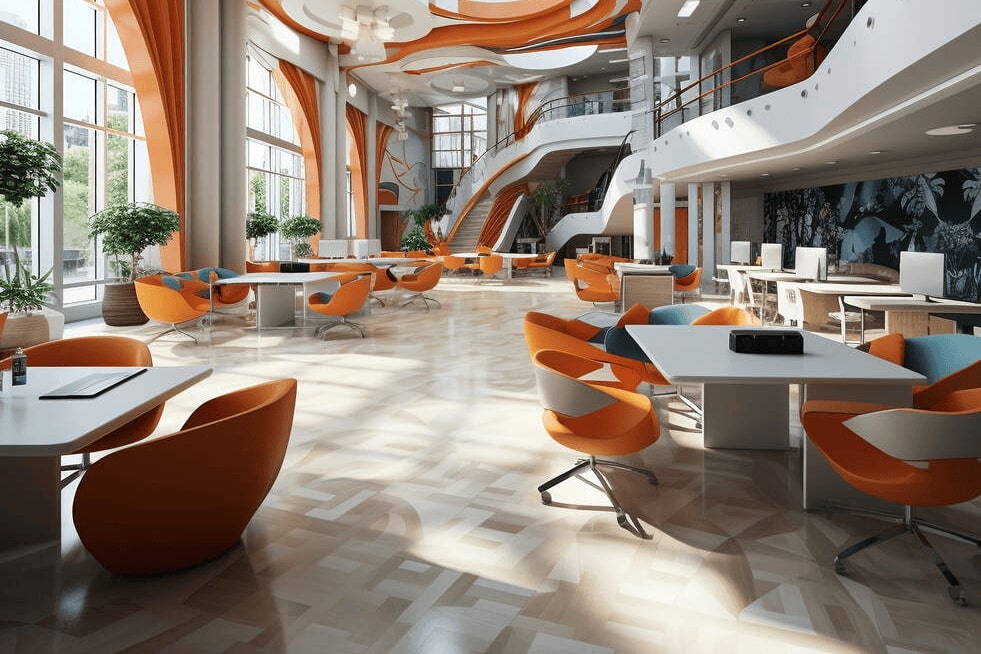
The Indian office landscape is evolving faster than ever, and with it, the way we design, experience, and inhabit workplaces. According to the Colliers India Office Snapshot Q2 2025, leasing across the top seven cities touched 17.8 million sq. ft., marking an 11% annual rise. It is a clear signal that companies are once again investing in spaces that reflect purpose, productivity, and culture. But what does this mean for office interior design, and how are modern office interiors adapting to this dynamic growth?
A Market on the Move
Cities like Bengaluru, Hyderabad, and Pune continue to lead the office demand, collectively driving nearly half of India’s leasing activity. Technology and BFSI sectors remain the biggest occupiers, while flex spaces surged by 65% YoY, accounting for nearly a fifth of all leasing. This shift towards flexibility is directly influencing how designers approach workspace design ideas. The spaces must now balance collaboration, adaptability, and wellness without losing sight of brand identity.
For both designers and developers, this means creating interiors that not only look aesthetically pleasing but also function intelligently. Acoustic zoning, modular layouts, agile furniture, and digital-ready infrastructure are no longer “premium” features; they’re essential ingredients of a future-ready workplace.
Designing for a Flexible Workforce
The rise of flex spaces has redefined what a “modern office” looks like. Gone are the days of rigid cubicles and fixed seating plans. Today’s modern office interiors celebrate movement and choice, from casual lounges and quiet pods to collaborative zones and touchdown areas.
For instance, Bengaluru’s Outer Ring Road and Whitefield together contribute nearly 70% of the city’s Grade A demand. The interiors are being designed with plug-and-play flexibility. Companies can scale up or down quickly, while employees enjoy a spatial rhythm that supports deep focus, creativity, and well-being.
In Hyderabad, where demand is booming across the off-SBD (Gachibowli and Nanakramguda) markets, offices are evolving into community-driven ecosystems. They are complete with green terraces, open cafeterias, and amenity-rich floors that blur the line between work and leisure. The corporate office decoration trend here is not about grandeur but experience, which means how the design makes people feel, move, and connect.
The Return of Purposeful Design
As leasing activity strengthens, companies are reevaluating their physical spaces as brand touchpoints. Offices are no longer just operational hubs; they are storytelling tools. From reception lounges that communicate brand ethos to breakout zones that mirror company culture, office interior design today is deeply narrative.
Cities like Mumbai and Delhi NCR, where rentals have firmed up significantly (8–12% YoY), are seeing a wave of purpose-driven office design, which is minimalist, tech-integrated, and sustainability-led. The shift isn’t just aesthetic; it’s strategic. Materials, lighting, and layout decisions now serve employee engagement goals as much as operational ones.
Workspace Design Ideas for the New Era
The Colliers report hints at a clear trend: growth is not uniform, but design is universal. No matter the city or sector, successful workplaces in 2025 share certain design philosophies:
- Biophilic Elements: Natural materials, indoor plants, and daylight integration create a calming, human-centric environment.
- Hybrid-Ready Layouts: Spaces must accommodate remote collaboration seamlessly with digital boards, soundproof booths, and adaptable meeting zones.
- Community Hubs: Offices are being reimagined as social anchors, fostering collaboration through shared lounges, coffee bars, and interactive installations.
- Sustainability and Local Craft: Designers are rethinking finishes and furniture with low-impact materials and locally sourced craftsmanship, aligning with global ESG goals.
- Smart Interiors: AI-driven lighting, climate control, and occupancy sensors enhance energy efficiency and user comfort.
These ideas aren’t just theoretical; they’re shaping the next generation of corporate office decoration strategies across India’s top business districts.
Regional Insights, Design Opportunities
- Bengaluru: With vacancy levels dropping and rents inching up, competition for Grade A spaces is intense. Interiors here emphasize space efficiency and brand differentiation, turning every square foot into an experience.
- Pune: Driven by the tech and engineering sectors, design here leans towards functional sophistication, which is ergonomic furniture, warm tones, and modular setups that scale effortlessly.
- Chennai: The dominance of BFSI and tech firms in leasing has led to balanced design aesthetics. The clean, calm spaces encourage focus, yet carry a subtle regional personality.
- Mumbai: With limited supply and rising rentals, design is becoming the new currency of value. Offices are investing in timeless interiors that justify long-term occupancy.
- Hyderabad: As one of the most active leasing markets, interiors celebrate open layouts and sustainability. These are the spaces that appeal to both startups and global tech giants.
Designing the Future Workplace
The office of tomorrow will be less about permanence and more about purpose. As organizations reimagine their physical footprint, office interior design is taking center stage in influencing talent attraction, productivity, and even brand perception. The Colliers data confirms what designers have long known: growth and design go hand in hand.
At firms like Whitehills Interior, this evolution is already underway. From concept to execution, every design narrative is built around creating future-ready workspaces: adaptive, aesthetic, and attuned to human needs.
Conclusion
The Indian office market’s steady rebound is not just a real estate story, but a design story. Every square foot leased represents a chance to rethink how people work, interact, and innovate. In 2025 and beyond, modern office interiors will continue to redefine success. And that will happen not only by how much space companies occupy, but by how meaningfully that space inspires its people.
